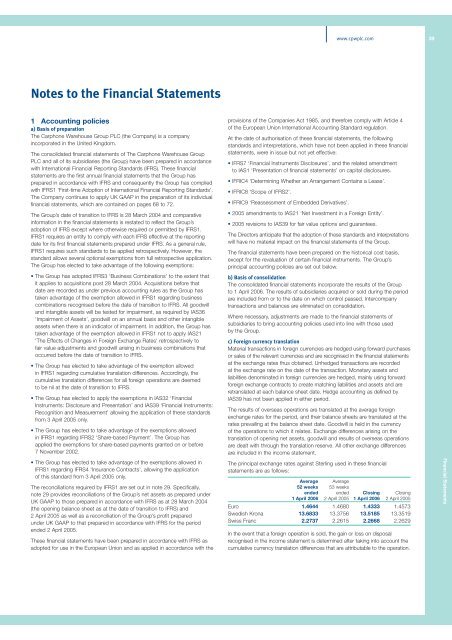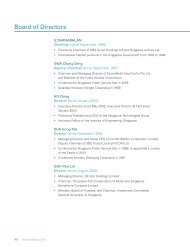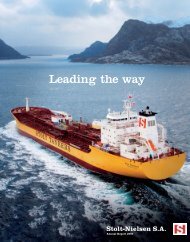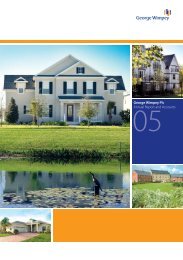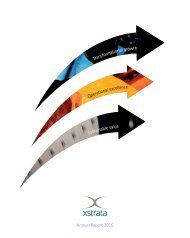Annual Report PDF - Carphone Warehouse Group plc
Annual Report PDF - Carphone Warehouse Group plc
Annual Report PDF - Carphone Warehouse Group plc
- No tags were found...
You also want an ePaper? Increase the reach of your titles
YUMPU automatically turns print PDFs into web optimized ePapers that Google loves.
www.cpw<strong>plc</strong>.com 39Notes to the Financial Statements1 Accounting policiesa) Basis of preparationThe <strong>Carphone</strong> <strong>Warehouse</strong> <strong>Group</strong> PLC (the Company) is a companyincorporated in the United Kingdom.The consolidated financial statements of The <strong>Carphone</strong> <strong>Warehouse</strong> <strong>Group</strong>PLC and all of its subsidiaries (the <strong>Group</strong>) have been prepared in accordancewith International Financial <strong>Report</strong>ing Standards (IFRS). These financialstatements are the first annual financial statements that the <strong>Group</strong> hasprepared in accordance with IFRS and consequently the <strong>Group</strong> has compliedwith IFRS1 ‘First-time Adoption of International Financial <strong>Report</strong>ing Standards’.The Company continues to apply UK GAAP in the preparation of its individualfinancial statements, which are contained on pages 68 to 72.The <strong>Group</strong>’s date of transition to IFRS is 28 March 2004 and comparativeinformation in the financial statements is restated to reflect the <strong>Group</strong>’sadoption of IFRS except where otherwise required or permitted by IFRS1.IFRS1 requires an entity to comply with each IFRS effective at the reportingdate for its first financial statements prepared under IFRS. As a general rule,IFRS1 requires such standards to be applied retrospectively. However, thestandard allows several optional exemptions from full retrospective application.The <strong>Group</strong> has elected to take advantage of the following exemptions:• The <strong>Group</strong> has adopted IFRS3 ‘Business Combinations’ to the extent thatit applies to acquisitions post 28 March 2004. Acquisitions before thatdate are recorded as under previous accounting rules as the <strong>Group</strong> hastaken advantage of the exemption allowed in IFRS1 regarding businesscombinations recognised before the date of transition to IFRS. All goodwilland intangible assets will be tested for impairment, as required by IAS36‘Impairment of Assets’, goodwill on an annual basis and other intangibleassets when there is an indicator of impairment. In addition, the <strong>Group</strong> hastaken advantage of the exemption allowed in IFRS1 not to apply IAS21‘The Effects of Changes in Foreign Exchange Rates’ retrospectively tofair value adjustments and goodwill arising in business combinations thatoccurred before the date of transition to IFRS.• The <strong>Group</strong> has elected to take advantage of the exemption allowedin IFRS1 regarding cumulative translation differences. Accordingly, thecumulative translation differences for all foreign operations are deemedto be nil at the date of transition to IFRS.• The <strong>Group</strong> has elected to apply the exemptions in IAS32 ‘FinancialInstruments: Disclosure and Presentation’ and IAS39 ‘Financial Instruments:Recognition and Measurement’ allowing the application of these standardsfrom 3 April 2005 only.• The <strong>Group</strong> has elected to take advantage of the exemptions allowedin IFRS1 regarding IFRS2 ‘Share-based Payment’. The <strong>Group</strong> hasapplied the exemptions for share-based payments granted on or before7 November 2002.• The <strong>Group</strong> has elected to take advantage of the exemptions allowed inIFRS1 regarding IFRS4 ‘Insurance Contracts’, allowing the applicationof this standard from 3 April 2005 only.The reconciliations required by IFRS1 are set out in note 29. Specifically,note 29 provides reconciliations of the <strong>Group</strong>’s net assets as prepared underUK GAAP to those prepared in accordance with IFRS as at 28 March 2004(the opening balance sheet as at the date of transition to IFRS) and2 April 2005 as well as a reconciliation of the <strong>Group</strong>’s profit preparedunder UK GAAP to that prepared in accordance with IFRS for the periodended 2 April 2005.These financial statements have been prepared in accordance with IFRS asadopted for use in the European Union and as applied in accordance with theprovisions of the Companies Act 1985, and therefore comply with Article 4of the European Union International Accounting Standard regulation.At the date of authorisation of these financial statements, the followingstandards and interpretations, which have not been applied in these financialstatements, were in issue but not yet effective:• IFRS7 ‘Financial Instruments Disclosures’, and the related amendmentto IAS1 ‘Presentation of financial statements’ on capital disclosures.• IFRIC4 ‘Determining Whether an Arrangement Contains a Lease’.• IFRIC8 ‘Scope of IFRS2’.• IFRIC9 ‘Reassessment of Embedded Derivatives’.• 2005 amendments to IAS21 ‘Net Investment in a Foreign Entity’.• 2005 revisions to IAS39 for fair value options and guarantees.The Directors anticipate that the adoption of these standards and interpretationswill have no material impact on the financial statements of the <strong>Group</strong>.The financial statements have been prepared on the historical cost basis,except for the revaluation of certain financial instruments. The <strong>Group</strong>’sprincipal accounting policies are set out below.b) Basis of consolidationThe consolidated financial statements incorporate the results of the <strong>Group</strong>to 1 April 2006. The results of subsidiaries acquired or sold during the periodare included from or to the date on which control passed. Intercompanytransactions and balances are eliminated on consolidation.Where necessary, adjustments are made to the financial statements ofsubsidiaries to bring accounting policies used into line with those usedby the <strong>Group</strong>.c) Foreign currency translationMaterial transactions in foreign currencies are hedged using forward purchasesor sales of the relevant currencies and are recognised in the financial statementsat the exchange rates thus obtained. Unhedged transactions are recordedat the exchange rate on the date of the transaction. Monetary assets andliabilities denominated in foreign currencies are hedged, mainly using forwardforeign exchange contracts to create matching liabilities and assets and areretranslated at each balance sheet date. Hedge accounting as defined byIAS39 has not been applied in either period.The results of overseas operations are translated at the average foreignexchange rates for the period, and their balance sheets are translated at therates prevailing at the balance sheet date. Goodwill is held in the currencyof the operations to which it relates. Exchange differences arising on thetranslation of opening net assets, goodwill and results of overseas operationsare dealt with through the translation reserve. All other exchange differencesare included in the income statement.The principal exchange rates against Sterling used in these financialstatements are as follows:Average Average52 weeks 53 weeksended ended Closing Closing1 April 2006 2 April 2005 1 April 2006 2 April 2005Euro 1.4644 1.4680 1.4333 1.4573Swedish Krona 13.6833 13.3756 13.5185 13.3519Swiss Franc 2.2737 2.2615 2.2668 2.2629In the event that a foreign operation is sold, the gain or loss on disposalrecognised in the income statement is determined after taking into account thecumulative currency translation differences that are attributable to the operation.Financial Statements


